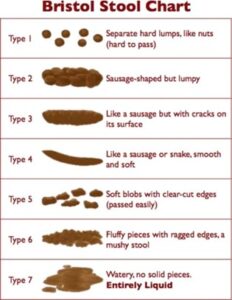Though it might sound revolting, inspecting your bowel motions can give you important insights into the health of your gut. Changes in the colour, form and frequency can indicate digestive issues, bacterial, yeast or parasite infections, or more serious health problems, such as cancer. Symptoms such as bloating, reflux, abdominal discomfort, nausea, fatigue, brain fog, weight loss/gain or changes in appetite can also suggest that all is not well with your gut.
The Bristol Stool Chart categorises stools into seven types. Ideally you want to be type 4 (sausage-like and easy to pass), and having a bowel motion 1 – 2 times daily.
 Types 1 and 2 are hard, lumpy, and often painful to pass. This suggests they have been sitting in the large intestine for too long and are indicative of constipation. Opioid medications, dehydration, stress and anxiety, inadequate dietary fibre, overgrowth of methane-producing bacteria could be contributing factors.
Types 1 and 2 are hard, lumpy, and often painful to pass. This suggests they have been sitting in the large intestine for too long and are indicative of constipation. Opioid medications, dehydration, stress and anxiety, inadequate dietary fibre, overgrowth of methane-producing bacteria could be contributing factors.
Types 5 – 7 are watery and loose. This suggests food may be passing through the digestive tract far too rapidly, not giving your body sufficient time to absorb the nutrients it needs. Diarrhoea can be caused by many factors including food intolerances, medication, stress, infections, and an overgrowth of hydrogen-producing bacteria.
Healthy stools are normally brown. If they are black or red this may be due to bleeding somewhere in the gastrointestinal tract, while stools that are grey are indicative of liver issues. Yellow smelly stools that leave a greasy film in the toilet, suggests the body isn’t absorbing fat properly.
Gut transit time is how long food takes to pass through your system, which optimally should be between 24 – 48 hours. When food passes through your digestive tract too quickly or too slowly, it can affect the appearance of your stool. An easy way to check transit time is by doing the sesame seed challenge. Mix two tablespoons of sesame seeds with some yoghurt and eat, noting date and time. When you first notice them in your stool write down the date and time, and again when you roughly see the last of those polka dots in your stool.
What you can do for healthy bowels
- Eating a wholefood diet (foods in their most natural state), including 5+ servings of brightly coloured vegetables a day. Vegetables are a great source of soluble and insoluble fibre, and can hugely help with a constipation picture. Inulin, partially hydrolyzed guar gum, and glucomannan are specific prebiotic fibres that may also provide some relief.
- Ensure you are drinking enough water, aiming for 30ml per kg of body weight. Water helps to eliminate toxins from the body via urine, bowels and skin.
- Exercise can increase digestive motility and regularity, helping to ease constipation.
- Supporting motility is vital. Fresh ginger root tea can help stimulate the digestive system and get things moving (allow to steep in hot water for 10 minutes before drinking).
- Stress management is key. Diaphragmatic breathing is a helpful technique that not only takes the nervous system out of “fight or flight” into a “rest and digest” state, it massages digestive organs helping to improve digestion and reduce gut symptoms.
- SIBO (small intestinal bacterial overgrowth) breath tests and Microbiome stool analysis are functional tools that provide further information about the health of your gut.


